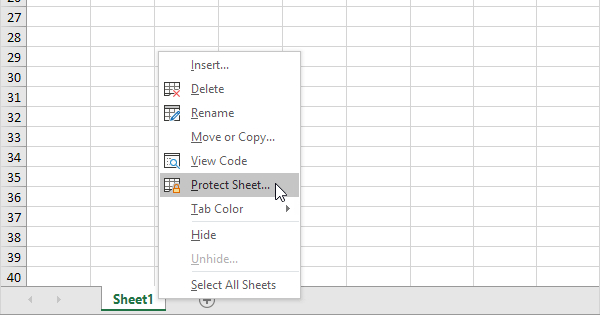5 Simple Ways to Lock Sheets in Excel Workbook

The ability to lock specific sheets or entire workbooks in Microsoft Excel provides an essential layer of security and control over sensitive data. Whether you're collaborating with a team, presenting data, or managing financial records, locking sheets ensures that formulas, data, and layout remain unchanged by unauthorized users. Here are five straightforward methods to lock sheets in Excel, ensuring your spreadsheets remain as you intended.
Method 1: Protecting Individual Sheets

One of the most basic yet effective ways to protect your data is by locking individual sheets:
- Open the Excel workbook and navigate to the sheet you wish to protect.
- Click on the “Review” tab from the ribbon at the top.
- Select “Protect Sheet.” A dialog box will appear.
- Here, you can customize what actions users can take with checkboxes:
- Select locked cells
- Format cells, columns, or rows
- Sort data
- Use AutoFilter
- Change comments
- Enter password to unprotect sheet (optional but recommended)
- Click “OK” to apply protection. If you’ve set a password, you will need to confirm it.
🗝️ Note: Remember your password; if you forget it, Microsoft cannot help you recover it.
Method 2: Workbook Protection

Instead of locking individual sheets, you can secure the entire workbook to prevent structural changes:
- Under the “Review” tab, find and click “Protect Workbook.”
- Select the type of protection you want:
- Structure - Prevents users from adding, deleting, renaming, or moving sheets.
- Windows - Prevents changes to window sizes or views.
- Optional: Add a password for enhanced security.
- Press “OK” to enable workbook protection.

Method 3: Locking Specific Ranges

You might want to allow editing in some parts while protecting others:
- Select the range or cell you want to lock or unlock.
- Right-click and choose “Format Cells.”
- Go to the “Protection” tab. Here, you can uncheck the “Locked” box to allow editing.
- Protect the sheet as described in Method 1, but now users can only modify unlocked ranges.
🔑 Note: By default, all cells in Excel are locked; you must unlock cells to allow changes when the sheet is protected.
Method 4: Using Excel’s Macro VBA

For advanced users, VBA provides more granular control over sheet protection:
- Open the VBA editor by pressing Alt+F11 or through the Developer tab.
- In the left-hand pane, double-click on “ThisWorkbook” or any sheet.
- Type or paste your VBA code:
Sub ProtectSheet()
With ActiveSheet
.Protect Password:=“yourpassword”, DrawingObjects:=True, Contents:=True, Scenarios:=True
End With
End Sub
Sub UnprotectSheet()
With ActiveSheet
.Unprotect Password:=“yourpassword”
End With
End Sub
Method 5: Password Protection for Opening Workbooks

This method locks the workbook itself:
- Click “File” > “Info” > “Protect Workbook.”
- Choose “Encrypt with Password.”
- Enter your password and confirm it.
- The workbook will now require this password to open.

Ensuring your spreadsheets remain secure can be vital in professional environments. Each of these methods provides different levels of security and control, allowing you to choose the protection strategy that best fits your needs. Remember to combine these methods for a robust security approach. In doing so, you not only protect sensitive data but also maintain the integrity of your work.
Can I protect cells in a worksheet individually?

+
Yes, you can protect cells individually by unlocking them before protecting the entire sheet. Unlocked cells will remain editable while the rest of the sheet is protected.
Is there a way to bypass Excel’s password protection?

+
While bypassing Excel’s password protection is not recommended and potentially illegal, it’s important to use strong, memorable passwords to prevent unauthorized access.
What happens if I forget the password for opening a workbook?

+
Unfortunately, if you forget the password used to open a workbook, Microsoft offers no official way to recover or bypass the password. You would need to start anew or use third-party tools, which are not supported by Microsoft.